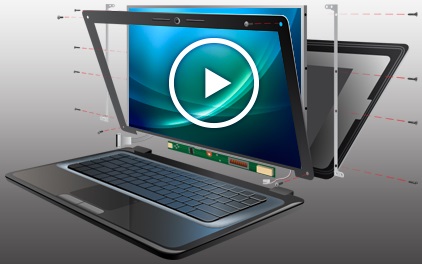
First of all, if your LCD screen has small black spots it can be just a dirt. In this case you will need to clean the screen. It is better to use distilled water (or tap water, at last resort) but not a solvent. Shut down your laptop before cleaning. Using a lint-free microfiber cloth is best, an old cloth can introduce dust. Finally, dry the screen with a dry cloth.
If small black spots did not disappear after cleaning or the spots are white or colorized, it is quite possible that the screen has faulty pixels. Faulty pixels can be different by nature. According to a typical classification, they can be stuck, hot, and dead. And consequently, they require different approaches to fix. At times, stuck pixels may start working with time again. Sometimes such pixels can be re-energized by turning them on and off rapidly (you can try to use some pixels-fixing software tools).
You may find many different advices on the Internet how to deal with faulty pixels. Some of them are worth to try, others may damage the screen (for instance, using an excessive heat). Anyway, it is better to try different approaches to fix these pixels (at least to make sure that the only one option is left). Unfortunately, if your screen has a dead or a partially dead pixels, in most cases there is nothing that you can do about it other than replacing your LCD screen with a new panel.
LCD screens are more fragile than old CRTs and faulty pixels can be easily contributed by users if pressure is put upon screen. As well as, the screen may have scratches. Some people try CD scratch remover but as a rule it makes the screen worse. The matter of fact, every LCD panel has a coating on top of the actual screen, this is what is scratched. Unfortunately, it can not be repaired. If your screen has many scratches, looks too ugly, then the most radical solution would be to replace the screen.
In case of dark screen, flicker, stripes, or other image problem, the first step should be to make sure that this is a screen problem, not other laptop's part. Therefore, it is necessary to check if other parts of laptop work. The easiest way is just to connect an external monitor through video output. If picture is good it means the laptop screen is non-functional or broken.
In case of dimmed screen or flicker it might be broken inverter or back-light bulb (that causes flicker). The back-light lamp is mounted inside the screen. When the back-light lamp fails, you have to replace the whole LCD screen (it is possible to replace only the lamp but very hard). All screen parts are supplied in one module that can be replaced.
If your screen is not repairable, a good cost-effective solution could be to replace the screen on your own. Are non-technical people capable to replace a laptop screen themselves? Evidently, yes. No doubt that most people are scared to change their laptop screen first time. But replacing LCD screen is easy. It is only slightly more difficult than changing a light-bulb: removing 6 screws, pulling off a bezel, disconnecting the old screen, and the installation of the new screen by following steps in reverse order. You may learn from some on-line illustrated guide how to replace LCD screen.
Since most laptop manufacturers charge too much, search for a good online store-retailer for your screen replacement (it should be within $50-150 depending on model). Some places carry a big inventory of brand new LCD panels to replace any notebook screen. If you are unable to find a particular model listed on their website, call or email them to find a screen replacement for your laptop.
Alex Smartson is a Technical Writer and SEO specialist at laptopscreen.comlaptop screens.
More Windows Troubleshooting Articles:
• Windows Don't Start Because of a Corrupted Registry
• Windows 7 Startup Modes for Troubleshooting
• Free Detailed PC Analysis
• Free Tool to Recover Files From Damaged Disc
• How to Fix Overheating Computer
• NTOSKRNL Missing or Corrupt Error Message
• How to Fix No Mouse Pointer Problem
• Video - Common Laptop Problems
• How to Fix Sqmapi.dll Error
• A Quality Freeware Hardware Diagnostic Tool

